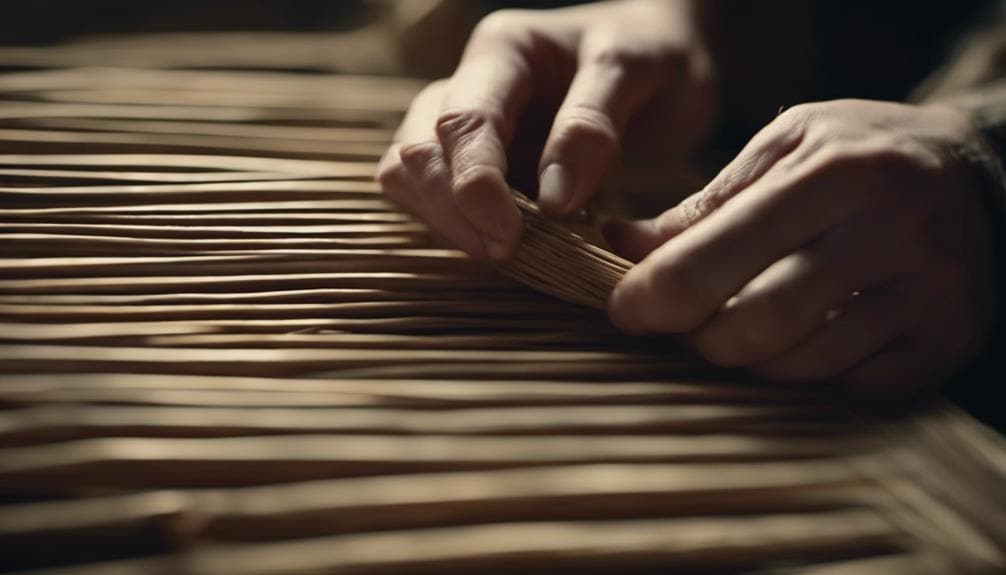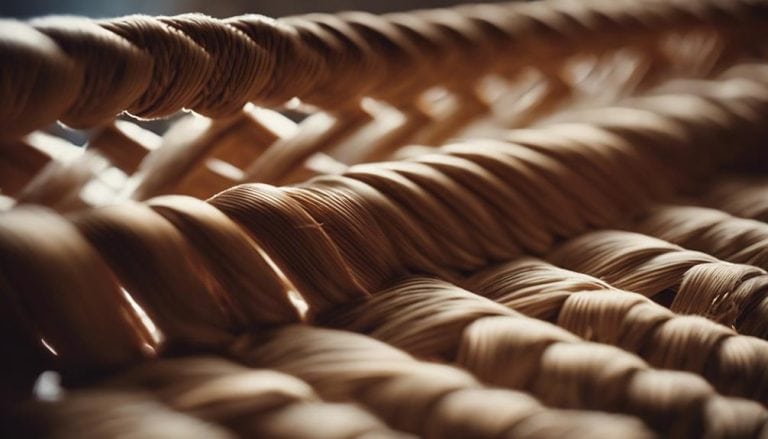Creating Art With Danish Cord and Rush Reeds
Have you ever wondered how traditional weaving techniques can be transformed into stunning works of art using Danish cord and rush reeds? Combining these natural materials to create unique pieces opens up a world of creative possibilities.
The artistry involved in this craft is truly captivating, from intricate patterns to durable structures. Join me as we explore the beauty and versatility of Danish cord and rush reeds, discovering how these materials can be masterfully woven into timeless pieces that elevate any space.
Creating art with Danish cord and rush reeds involves weaving or braiding the materials to form intricate patterns and designs. This technique is often used to make baskets, mats, and other decorative items.
Key Takeaways
- Danish cord and rush reeds offer versatility and customization for creating sophisticated and elegant woven art pieces.
- Master weaving techniques like twining and plaiting to replicate mid-century modern chair designs with Scandinavian craftsmanship.
- Maintain woven art with regular care and cleaning to ensure longevity and preserve the beauty of the intricate patterns.
- Explore artistic applications by transforming wooden frames and mastering tension control for durable and beautiful woven art.
Exploring the Versatility of Danish Cord
Exploring the versatility of Danish cord reveals a world of creative possibilities in weaving intricate patterns for furniture and art pieces. Danish cord, a durable paper cord, is the perfect medium for artisans to showcase their weaving skills, especially in crafting chair seats and furniture items. The strength and flexibility of the Danish cord make it ideal for designing complex patterns that add visual interest and functionality to pieces.
Danish cord offers a broad spectrum of customization options in art and design due to its availability in different thicknesses and colors. Artisans skillfully weave this cord around wooden frames, transforming them into visually appealing and sturdy furniture pieces. The utilization of the Danish cord not only highlights its adaptability but also underscores its aesthetic appeal in creative projects. Whether creating traditional chair seats or contemporary art installations, Danish cord stands out as a versatile material that elevates weaving to new heights.
Mastering the Art of Rush Reeds

Having delved into the versatility of Danish cord, we now turn our focus to mastering the intricate art of rush reed weaving. Rush reeds, derived from natural plant materials, offer woven pieces a unique texture and aesthetic.
To weave with rush reeds effectively, one must first soak the material to enhance flexibility and durability. Understanding the weaving patterns, such as herringbone, checkerboard, and twill, is essential for creating decorative effects that showcase the beauty of rush reeds.
Mastering rush reed weaving involves precise tension control to ensure a uniform and sturdy weave. Additionally, mastering corner techniques is crucial for creating seamless transitions and achieving professional-looking results. Finishing methods play a pivotal role in enhancing the durability and aesthetics of rush reed creations.
This traditional craft passed down for centuries, demands skill, dedication, and practice to achieve intricate designs that stand the test of time. Embrace the challenge, hone your skills, and unlock the true potential of rush reed weaving.
Design Inspiration With Danish Cord

With Danish cord as my muse, I embark on a design exploration journey, seeking inspiration to craft unique and timeless pieces that reflect the essence of Scandinavian craftsmanship. Danish cord offers creative possibilities through its intricate weaving patterns, making it a versatile medium for designing chair seats and furniture pieces.
Danish cord’s durability and visual appeal make it perfect for incorporating a touch of Scandinavian design into home decor, adding a sophisticated and elegant flair to any space. Skilled artisans adeptly use Danish cord to precisely replicate iconic mid-century modern chair designs, showcasing their mastery of the craft.
Techniques for Weaving With Rush Reeds

What intricate techniques are involved in weaving with rush reeds to create stunning and durable designs?
Weaving with rush reeds for seat weaving involves a blend of traditional craftsmanship and modern design sensibilities. The rush reeds, soaked in water for increased flexibility, are meticulously woven by hand to form intricate patterns like the herringbone twill pattern. This weaving technique requires a keen eye for detail and precision to ensure each cord is tightly woven to create durable seats for modern furniture.
In rush weaving, techniques such as twining, plaiting, braiding, and coiling are utilized to achieve patterns like checkerboard, herringbone, and diamond designs. Each cord is carefully intertwined to form a sturdy and visually appealing structure. The hand caning of rush reeds creates unique and stylish woven seats that add a touch of elegance to any piece of furniture. With their natural flexibility and strength, Rush reeds are the perfect choice for creating timeless and beautiful woven designs.
Maintenance Tips for Danish Cord Art

Creating stunning Danish cord art requires meticulous maintenance to preserve its beauty and longevity. This starts with regular dusting and careful placement to prevent damage from sunlight exposure.
Here are essential maintenance tips for Danish cord art:
- Regular Dusting: Use a soft cloth to gently dust the Danish cord art regularly, preventing the accumulation of dirt and maintaining its cleanliness.
- Avoid Sunlight: Keep Danish cord art away from direct sunlight to prevent fading and potential damage to the fibers over time.
- Spot Cleaning: To maintain the pristine condition of the art piece, use a mild soap solution and a damp cloth to spot clean spills or stains.
- Rotation: Periodically rotate the Danish cord art to ensure even wear and tear, prolonging its lifespan and preserving its original beauty.
Consider professional cleaning services for intricate Danish cord art pieces. These services ensure thorough maintenance and care beyond regular cleaning routines.
Incorporating Rush Reeds Into Home Decor

When incorporating rush reeds into home decor, one can effortlessly infuse natural textures and a rustic charm. The weaving process of rush reeds allows for the creation of unique pieces such as chair seats, backs, baskets, and mats, adding both functional and decorative elements to living spaces.
Danish Cord and rush reeds blend seamlessly to bring handmade charm and eco-friendly appeal to home decor. The sustainable nature of rush reeds makes them a perfect choice for those seeking to incorporate natural materials into their living spaces while maintaining a sense of style.
Whether dyed to match specific color schemes or left natural to enhance a rustic aesthetic, rush reeds offer versatility in design. By weaving rush reeds into home decor, one can create a cozy and inviting atmosphere that exudes a sense of craftsmanship and attention to detail, elevating the overall look and feel of the space.
Frequently Asked Questions
What Is the Difference Between Paper Rush and Danish Cord?
Paper rush, a softer, pliable material, contrasts with durable Danish cord coated with wax. Danish cord, favored for chair seats, offers a smooth, polished look. Both natural fibers suit weaving projects; paper rush excels in intricate designs, while Danish cord enhances furniture restoration.
What Is the Nail Spacing for Danish Cord Weaving?
Nail spacing for Danish cord weaving is crucial. It usually ranges from 1 to 1.25 inches apart. Consistent spacing maintains weave integrity and patterns. Skilled artisans measure precisely for tension and alignment. Proper spacing enhances durability and aesthetics.
How Much Danish Cord Do I Need?
I measure the seat frame perimeter to calculate the Danish cord length. Typically, 100 feet suffice for a standard chair. Account for weaving complexity and consider extras for mistakes. Experts’ advice aids in cord estimation accuracy.
What Is the Difference Between Laced and Unlaced Danish Paper Cord?
Laced and unlaced Danish paper cords differ in their weaving intricacy and strength. Laced cord offers durability for complex designs, while unlaced provides a smoother surface. Choose based on project complexity, aesthetics, and durability needs.
Conclusion
Creating art with Danish cord and rush reeds is like weaving a tapestry of memories. Each strand represents a unique thread in the fabric of our lives. Just as these materials are carefully intertwined to create beauty and durability, we must delicately weave our experiences together to form a rich and meaningful tapestry of existence.
Let the art of Danish cord and rush reeds inspire you to craft a masterpiece of your own life.







